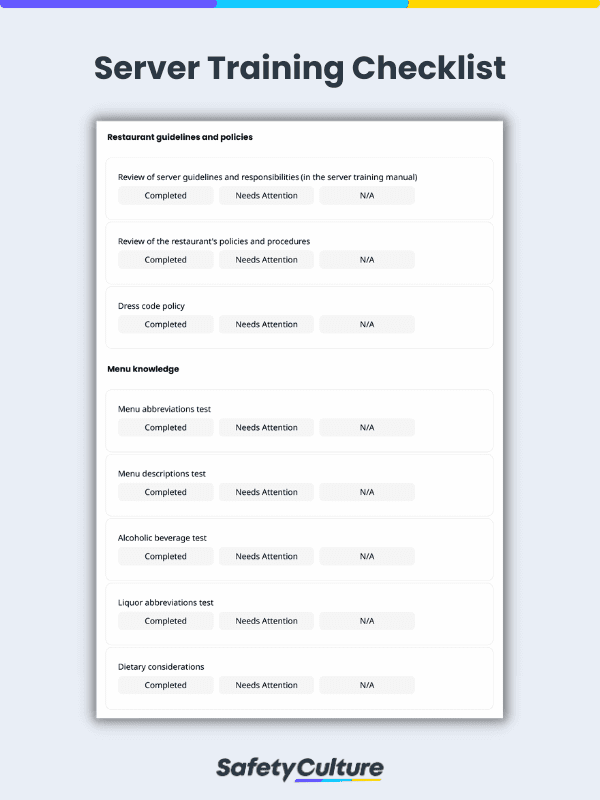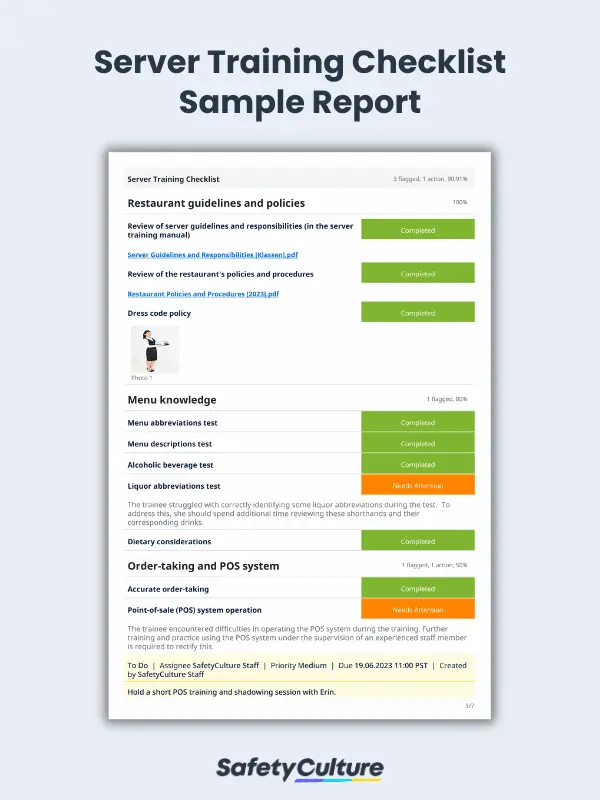What is a Server Training Checklist?
A server training checklist specifies the essential skills and tasks needed to provide excellent service in restaurant settings. It serves not only as a training tool for new hires but also as a refresher for present staff. This checklist covers activities related to restaurant operations, customer service, and specific job responsibilities.
Why Use a Checklist for Server Training Sessions
Server training consists of a multitude of tasks that new hires need to master, from restaurant policies and food safety to service etiquette and problem resolution. A checklist is an excellent reference guide for training managers, as it organizes these activities in a single document. This, in turn, allows training teams to carry out sessions more systematically.
In particular, this training checklist offers the following advantages:
- Structure – The checklist serves as a framework that covers all necessary topics and tasks during the training session, preventing essential aspects from being overlooked.
- Consistency – Following the contents of this checklist ensures all servers receive the same information and skills, regardless of who conducts the training. This, in turn, can make it easier for them to follow instructions, leading to fewer errors, reduced waiting times, and overall efficiency when they start their practice.
- Progress – A server training checklist sets the starting points against which the new hire will be evaluated. This way, trainers and trainees can track their progress and find areas that require additional support or training.
- Standardization – A checklist can also help establish and maintain consistent service standards throughout the restaurant. By adhering to the same practices and procedures, guests can enjoy a seamless dining experience whenever they visit your restaurant.
- Reference – Lastly, servers can always refer to this tool even after their initial training to refresh their knowledge or review specific procedures.
Essential Components
A server training checklist should cover the following key components:
- Restaurant guidelines and policies – found in the server training manual
- Menu knowledge – abbreviations and descriptions of menu items, alcoholic beverages, and dietary considerations
- Order-taking and Point-of-Sale (POS) system – ringing customer orders and operating the POS machine
- Serving etiquette – guest greeting, food and drink delivery, refills and second orders, guest check-backs
- Table setting and maintenance – tableware and order assembly, bussing procedure
- Upselling and customer recommendations – suggestive selling techniques for additional items, specials, or upgrades
- Payment billing and processing – writing food and bar checks, timely delivery and closing of customer checks
- Safety and hygiene – food safety guidelines, personal hygiene, and safe food storage and handling procedures
- Collaboration and teamwork – coordination with kitchen staff, rapport building with guests
- Other considerations – good knowledge and grasp of sidework tasks
Implementing Effective Server Training Programs
After learning the activities to include in your checklist, it’s time to integrate this knowledge into your server training program. Here are the steps for creating and carrying out training programs effectively in restaurant settings:
- Specify the goals and learning outcomes to achieve during the training program.
- Develop a detailed training plan outlining the tasks to be covered, the training approach, and the timeline for each activity or area.
- Prepare the materials to be used, including manuals, handouts, and visual aids. Ensure they’re clear, concise, and engaging.
- Select experienced trainers with excellent communication skills and in-depth knowledge of the restaurant’s operations, service procedures, and menu offerings.
- Introduce the servers to the restaurant’s culture, policies, and best practices, alongside an overview of what they can expect from the day’s session.
- Combine theoretical and hands-on training methods to help servers understand and apply their knowledge in real-world situations.
- Assign new servers a mentor to guide them in the process, answer questions, provide constructive feedback, and address any concerns.
- Assess the servers’ progress and adjust your approach based on the identified areas for improvement.
FAQs about Server Training
Server training typically lasts from a few days to a few weeks. This can change depending on the complexity of the restaurant’s menu, the level of experience of the servers, and the training method used. Regardless, it’s important to give servers enough time to learn and practice the necessary skills before they start serving customers independently.
In general, it’s best to review server training checklists periodically based on the most relevant and up-to-date information. The checklist should reflect any change in the restaurant’s menu, policies, and procedures. Regularly incorporating feedback from experienced servers can also improve the effectiveness of this tool over time.
Restaurants and similar establishments can gauge how effective their server training checklist is based on the performance of the staff members who have undergone training. Here are a few approaches to consider when measuring this:
- Mystery shopper evaluations
- Customer feedback (e.g., customer satisfaction surveys)
- Sales and upselling metrics
- Employee performance reviews
- Operational efficiency




